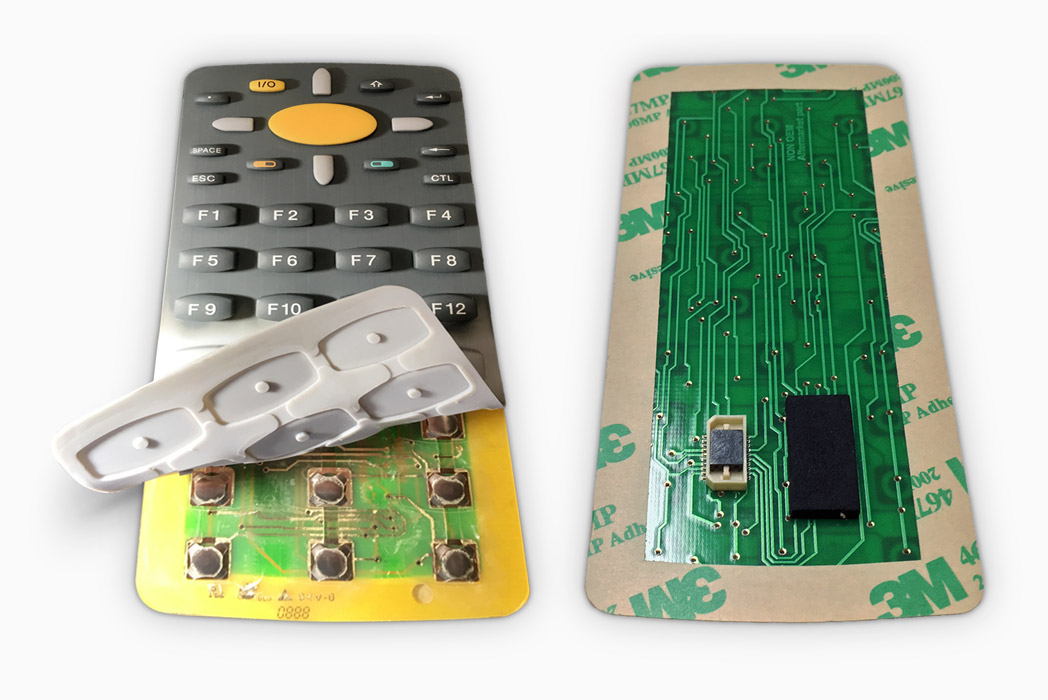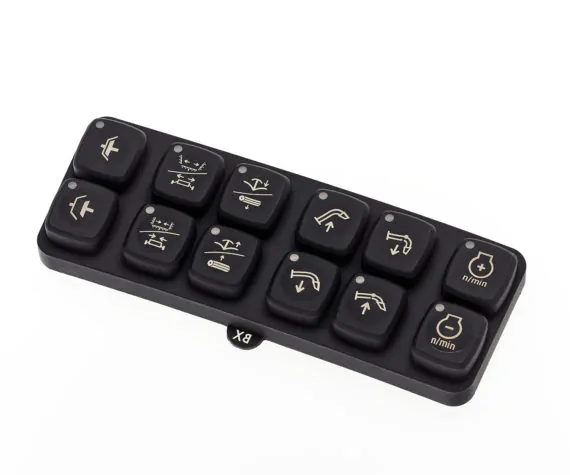Discovering the Manufacturing Refine Behind Rubber Keypads and Their Value in Modern Gadgets
Rubber keypads are crucial in the capability of modern-day tools. Their production process involves mindful selection of materials and exact strategies. Keypads are created to improve individual interaction while guaranteeing sturdiness and integrity. Recognizing how these parts are made discloses their significance throughout different applications. What aspects contribute to their efficiency, and exactly how do these aspects influence individual experience? The responses might improve perceptions of this everyday innovation.
Overview of Rubber Keypads and Their Applications

Rubber keypads are functional parts commonly made use of in numerous electronic tools, varying from customer electronics to commercial equipment. Their design permits a tactile action, making them an ideal choice for applications requiring individual communication. Commonly located in items such as push-button controls, calculators, and clinical devices, rubber keypads facilitate ease of usage and ease of access.
In industrial setups, they offer vital features in equipment and control panels, where resilience and resistance to ecological aspects are important. The non-slip surface improves grasp, promoting reliability sought after conditions. Additionally, their light-weight nature and customizable shapes allow makers to produce tailored remedies that fit certain needs. With advancements in modern technology, rubber keypads continue to progress, integrating functions like backlighting and improved sensitivity. In general, their versatility and practical advantages contribute considerably to the effectiveness of various gadgets throughout several industries.
Materials Used in Rubber Keypad Manufacturing
Keypad producing depends on a choice of materials that enhance both performance and resilience. The primary product made use of in the production of rubber keypads is silicone rubber, known for its excellent strength and flexibility. This product enables keypads to stand up to repeated pressing without losing shape or performance. Furthermore, thermoplastic elastomers (TPE) are usually utilized due to their convenience of molding and ability to offer a soft-touch feel.
Coloring agents, such as pigments, are included to ensure lively, long-lasting shades that enhance aesthetic allure. Ingredients like anti-UV representatives and flame resistants may be mixed right into the rubber to enhance climate resistance and security compliance. The choice of materials straight impacts the keypad's responsive reaction, long life, and general performance in various devices. Eventually, the mindful choice of these elements is crucial for the production of high-grade rubber keypads that satisfy customer and industry demands.
The Layout Refine of Rubber Keypads
When producing rubber keypads, the layout procedure plays a crucial role in figuring out capability and customer experience. Developers begin by defining the keypad's meant use, thinking about elements such as the tool it will accompany and the target individual market. This preliminary phase includes laying out formats that focus on ergonomic facets, making certain the secrets are quickly accessible and suitably spaced.
Next off, developers concentrate on the responsive comments preferred from the keypads, which affects the choice of materials and essential forms. Prototyping is vital in this stage, enabling designers to evaluate different designs for comfort and responsiveness.

Production Techniques for Rubber Keypads
The production process for rubber keypads involves a series of precise strategies that ensure high quality and functionality. Liquid silicone rubber (LSR) is usually made use of due to its resilience and versatility. The procedure starts with blending the raw products, including silicone, colorants, and healing representatives. This combination is after that injected into molds designed to shape the keypads precisely.
Complying with injection, the molded keypads undertake treating, a home heating procedure that strengthens the material (Rubber Keypads). This is typically performed in a press, guaranteeing the keypads accomplish the wanted hardness and strength
Top Quality Control Measures in Manufacturing
To assure that rubber keypads meet high criteria of quality and capability, extensive high quality control measures are carried out throughout the production procedure. These actions start with resources inspection, guaranteeing that just the highest-grade elastomers are used. Throughout the production phase, operators carry out normal checks to check specifications such as temperature level, pressure, and mixing times, vital for accomplishing constant product high quality.
Post-production, each set of keypads goes through thorough testing, consisting of responsive action assessments and longevity tests to examine efficiency under numerous conditions. Aesthetic inspections are likewise conducted to recognize any type of problems, such as bubbles or incongruities in texture. Furthermore, conformity with sector criteria is confirmed, making certain that the keypads meet security and performance benchmarks.
The Role of Technology in Keypad Development
Innovation plays a crucial duty in the growth of rubber keypads by allowing sophisticated manufacturing methods that enhance precision and effectiveness. In addition, innovative material option permits enhanced toughness and responsiveness in keypad efficiency. These developments not only enhance manufacturing however also elevate the total top quality of the end product.
Advanced Manufacturing Techniques
Developments in production strategies reinvent the manufacturing of rubber keypads, enhancing both performance and precision. Technologies such as injection molding and 3D printing have actually transformed traditional procedures, making it possible for manufacturers to develop complicated designs with lowered waste and improved turnaround times. Automation plays a necessary duty in this development, improving setting up lines and reducing human mistake. In addition, computer-aided style (CAD) software application permits detailed customization, making certain that keypads satisfy details individual demands. Quality control steps have additionally advanced, including real-time monitoring systems that find problems early in the production cycle. These innovations not only improve the longevity and capability of rubber keypads however additionally sustain the expanding demand for personalized solutions in different markets, from consumer electronic devices to automotive applications.
Cutting-edge Material Option
The development of making techniques has led the way for ingenious material choice in rubber keypad advancement. Breakthroughs in polymer science have actually introduced products that boost sturdiness, adaptability, and responsive responses. Makers now use polycarbonate elastomers (TPE) and silicone compounds, which give premium resistance to wear and ecological aspects. These products permit for the creation of keypads that can endure prolonged usage while maintaining aesthetic allure. In addition, the integration of ingredients and finishes boosts functionality, such as improving grip and reducing rubbing. The choice of materials is essential, as it straight influences the efficiency and longevity of keypads in different gadgets, from customer electronics to commercial devices. This ingenious Full Report technique remains to shape the future of keypad layout and functionality.
The Effect of Rubber Keypads on Customer Experience
Rubber keypads considerably affect customer experience through their improved tactile reaction, which permits even more specific interaction. In addition, their resilience and longevity add to consistent performance with time, lowering the demand for frequent substitutes. This mix of functions makes rubber keypads a recommended choice in numerous applications, ultimately affecting customer fulfillment.
Improved Tactile Action
Enhancing tactile action significantly affects user experience, specifically in gadgets that depend on keypads for interaction. Rubber keypads provide an one-of-a-kind combination of softness and resilience, permitting individuals to feel distinct responses with each press. This comments enhances a feeling of control and precision, vital in applications ranging from smartphones to commercial equipment. Individuals often report greater satisfaction and performance when interacting with tools that include well-designed rubber keypads, as they help with quicker and extra accurate input. Furthermore, the ergonomic design of these keypads can decrease finger tiredness, advertising longer use durations without pain. Generally, the boosted responsive reaction offered by rubber keypads considerably contributes to an extra pleasurable and instinctive individual experience in contemporary technology.
Resilience and Long life
A vital facet of customer experience with rubber keypads lies in their longevity and durability. These keypads are created to withstand extensive use, standing up to deterioration that typically influences various other materials. The robust nature of rubber warranties that keypads preserve their performance and look gradually, which is vital for devices regularly made use of in numerous atmospheres. Users take advantage of the dependability of rubber keypads, as they can sustain direct exposure to dampness, dirt, and temperature variations without weakening. This strength not only enhances customer contentment but also minimizes the demand for regular substitutes, ultimately adding to cost-effectiveness for suppliers. Essentially, the resilience of rubber keypads greatly affects the general efficiency and customer experience in contemporary gadgets.
Often Asked Concerns
The Length Of Time Do Rubber Keypads Typically Last in Devices?
Rubber keypads normally last in between 5 to one decade, depending on usage, ecological elements, and top quality of products utilized (Rubber Keypads). Regular damage can shorten their lifespan, affecting capability and individual experience with time
Can Rubber Keypads Be Customized for Details Applications?
Rubber keypads can indeed be customized for particular applications, enabling changes in dimension, shape, color, and appearance. This flexibility allows manufacturers to produce customized options that satisfy varied user requirements and enhance capability in various devices.
Are Rubber Keypads Ecologically Friendly?
Rubber keypads are frequently not considered environmentally pleasant due to their petroleum-based products. Nonetheless, developments in sustainable production practices and the growth of bio-based options are slowly enhancing their environmental influence in numerous applications.
What Prevail Problems Encountered Throughout Rubber Keypad Production?
Usual this link problems faced throughout rubber keypad production consist of irregular material top quality, mold flaws, improper healing times, bond failures, and challenges in Check This Out achieving accurate responsive feedback. These problems can cause decreased item efficiency and consumer frustration.
How Do Rubber Keypads Contrast to Various Other Sorts Of Key Switches Over?
Rubber keypads provide a softer feeling and quieter operation contrasted to mechanical buttons, which provide responsive comments. Nonetheless, rubber keypads may put on out faster and lack the precision that some users choose in high-performance applications.
The key material used in the production of rubber keypads is silicone rubber, understood for its exceptional resilience and adaptability. When creating rubber keypads, the layout process plays a necessary function in establishing capability and individual experience. Rubber keypads considerably affect user experience with their boosted tactile feedback, which allows for even more exact interaction. Users usually report better satisfaction and efficiency when engaging with tools that include properly designed rubber keypads, as they facilitate quicker and much more exact input. A vital facet of user experience with rubber keypads exists in their longevity and durability.